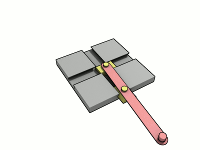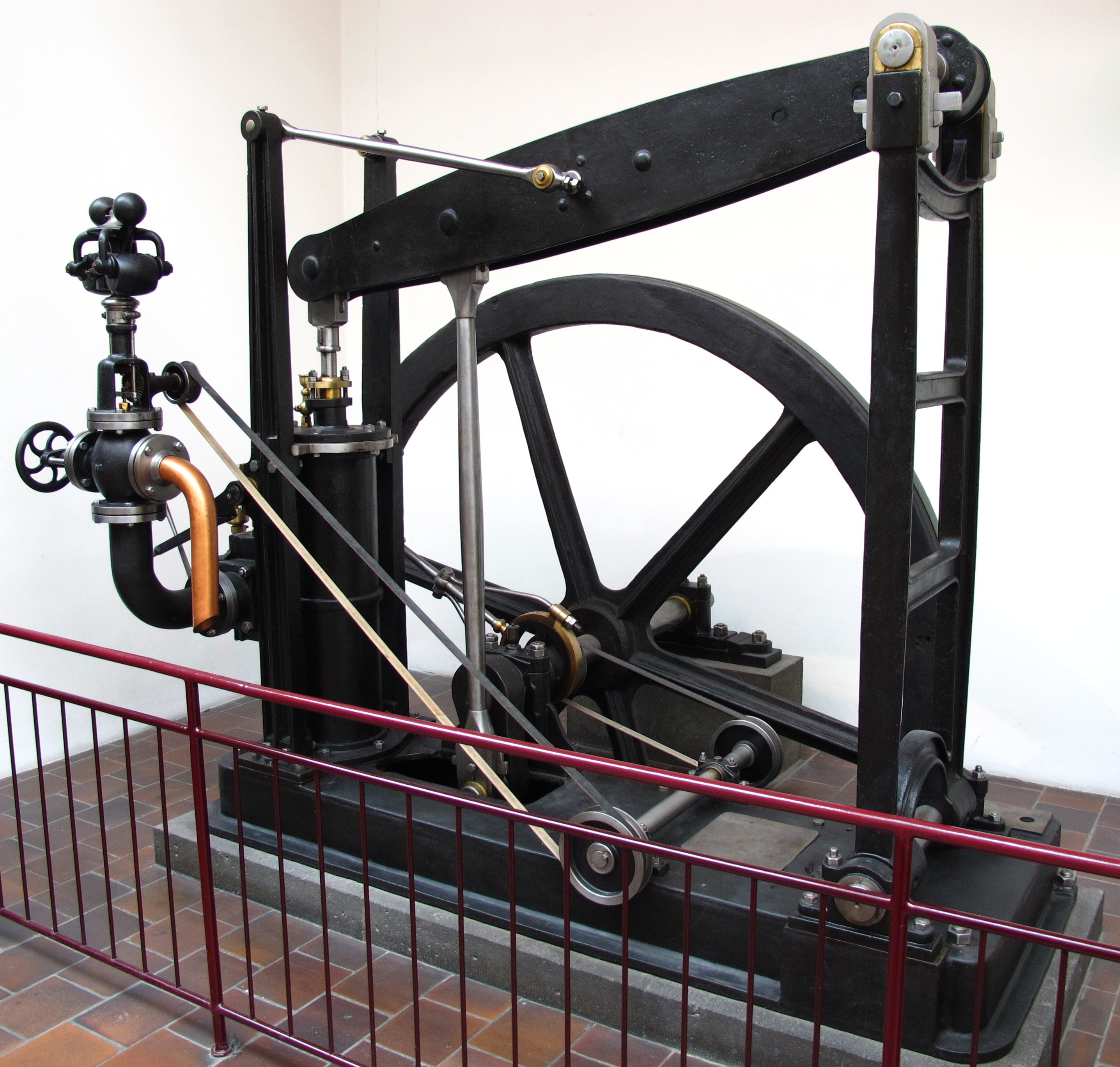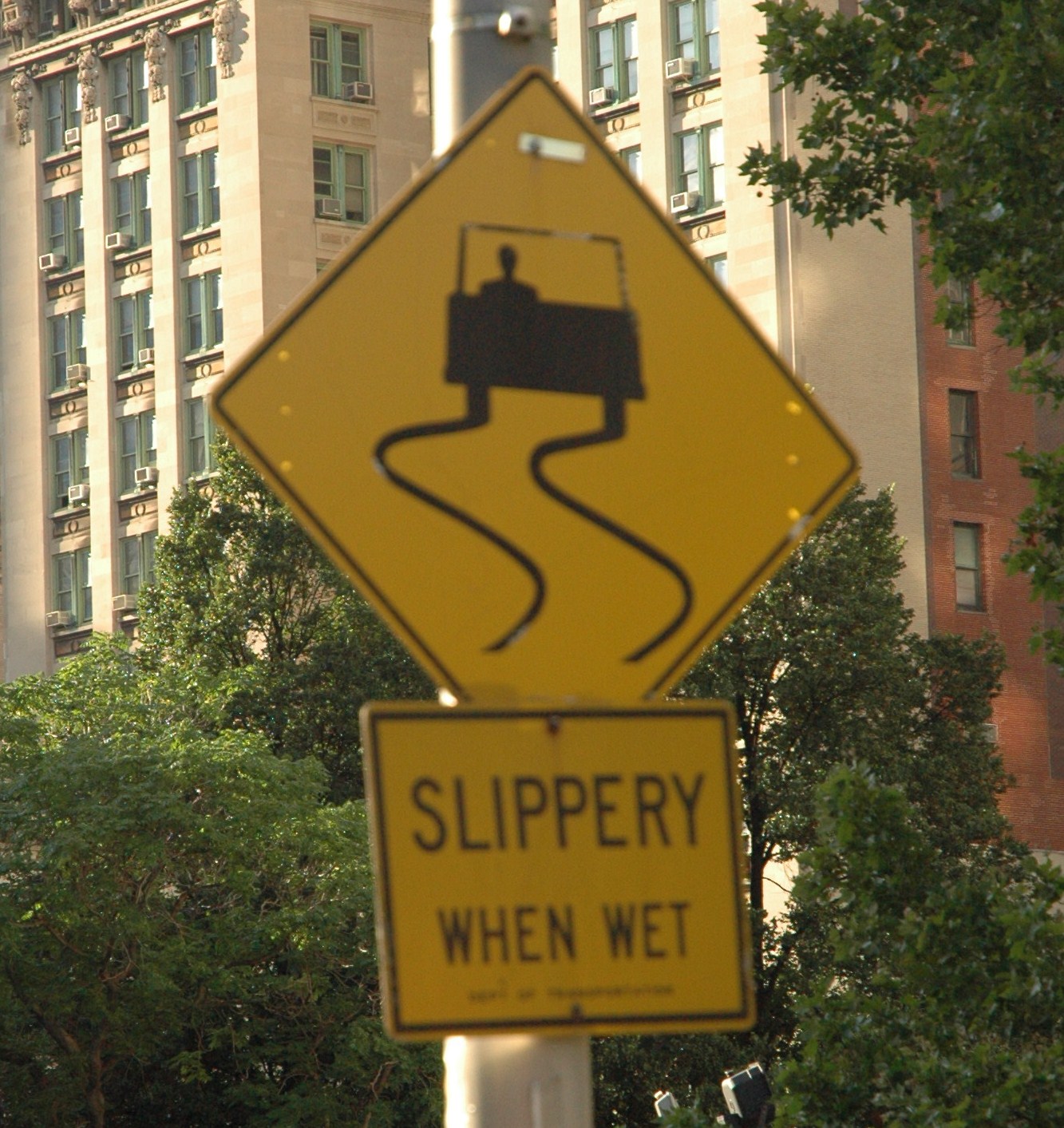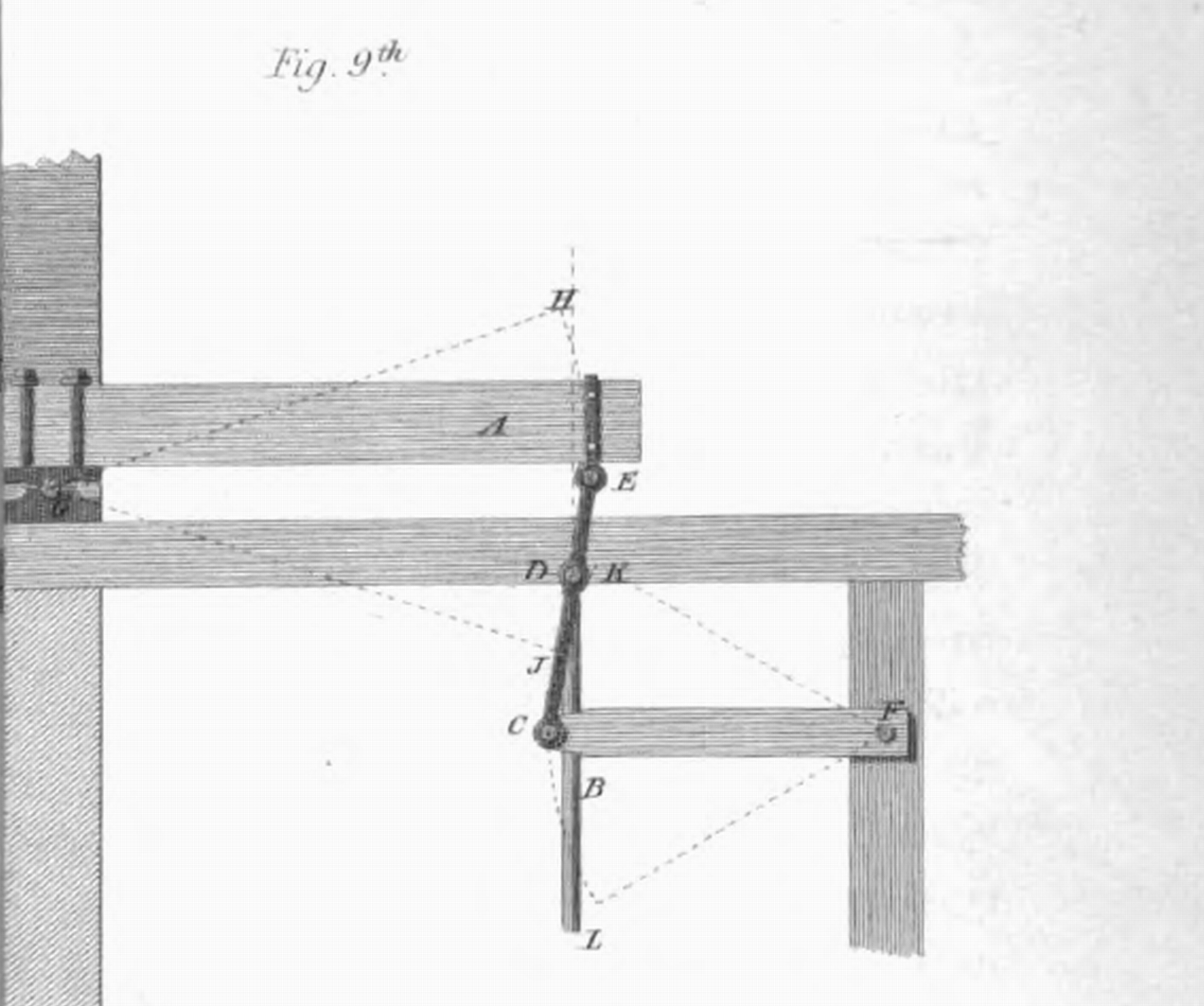|
Scott Russell Linkage
A Scott Russell linkage is a linkage which translates linear motion through a right angle. The linkage is named after John Scott Russell (1808–1882), although watchmaker William Freemantle had already patented it in 1803. A different form of the linkage has been used in a front-wheel-drive vehicle with solid rear axle to control lateral movement, and with a flexing elastomeric connection instead of the rolling or sliding connection. The linkage does not share the disadvantages of the asymmetric Panhard rod, and although more compact than Watt's linkage, it has all the forces concentrated in one link. Construction and related linkages The linkage is composed of two links. One link is double the size of the other, and is connected to the smaller link by its midpoint. One of the ends is then connected to something that can generate linear motion, such as a rolling or sliding connection, or another straight line mechanism. The Evans 'grasshopper' linkage is a variant of a ... [...More Info...] [...Related Items...] OR: [Wikipedia] [Google] [Baidu] |
Linkage (mechanical)
A mechanical linkage is an assembly of systems connected to manage forces and movement. The movement of a body, or link, is studied using geometry so the link is considered to be rigid. The connections between links are modeled as providing ideal movement, pure rotation or sliding for example, and are called joints. A linkage modeled as a network of rigid links and ideal joints is called a kinematic chain. Linkages may be constructed from open chains, closed chains, or a combination of open and closed chains. Each link in a chain is connected by a joint to one or more other links. Thus, a kinematic chain can be modeled as a graph in which the links are paths and the joints are vertices, which is called a linkage graph. The movement of an ideal joint is generally associated with a subgroup of the group of Euclidean displacements. The number of parameters in the subgroup is called the degrees of freedom (DOF) of the joint. Mechanical linkages are usually designed to tra ... [...More Info...] [...Related Items...] OR: [Wikipedia] [Google] [Baidu] |
Rolling
Rolling is a type of motion that combines rotation (commonly, of an axially symmetric object) and translation of that object with respect to a surface (either one or the other moves), such that, if ideal conditions exist, the two are in contact with each other without sliding. Rolling where there is no sliding is referred to as ''pure rolling''. By definition, there is no sliding when there is a frame of reference in which all points of contact on the rolling object have the same velocity as their counterparts on the surface on which the object rolls; in particular, for a frame of reference in which the rolling plane is at rest (see animation), the instantaneous velocity of all the points of contact (e.g., a generating line segment of a cylinder) of the rolling object is zero. In practice, due to small deformations near the contact area, some sliding and energy dissipation occurs. Nevertheless, the resulting rolling resistance is much lower than sliding friction, and thus, roll ... [...More Info...] [...Related Items...] OR: [Wikipedia] [Google] [Baidu] |
Trammel Of Archimedes
A trammel of Archimedes is a mechanism that generates the shape of an ellipse. () It consists of two shuttles which are confined ("trammeled") to perpendicular channels or rails and a rod which is attached to the shuttles by pivots at fixed positions along the rod. As the shuttles move back and forth, each along its channel, all points on the rod move in elliptical paths. The motion of the rod is termed elliptical motion. The semi-axes ''a'' and ''b'' of the ellipses have lengths equal to the distances from the point on the rod to each of the two pivots. The straight lines described by the pivots are special cases of an ellipse, where the length of one axis is twice the distance between the pivots and that of the other is zero. All points on a circle with a diameter defined by the two pivots reciprocate in such straight lines. This circle corresponds to the smaller circle in a Tusi couple. The point midway between the pivots orbits in a circle around the point where the chan ... [...More Info...] [...Related Items...] OR: [Wikipedia] [Google] [Baidu] |
Grasshopper Beam Engine
Grasshopper beam engines are beam engines that are pivoted at one end, rather than in the centre. Usually the connecting rod to the crankshaft is placed ''between'' the piston and the beam's pivot. That is, they use a second-class lever, rather than the usual first-class lever. Origins The first recorded example of a grasshopper beam was William Murdoch's model steam carriage of 1784. The beam offered negligible mechanical advantage and appears to have been used primarily instead of a crosshead, for what was effectively a return connecting rod engine. The American engineer Oliver Evans drew a high-pressure marine grasshopper engine in 1801,A concept similar to Trevithick's high-pressure locomotive of the same period. and in 1805 built the '' Oruktor Amphibolos'', an amphibious dredger. Almost all grasshopper engines placed the crankshaft between the piston and the beam's pivot. This allows a long stroke for the piston, with a shorter stroke for the crank, although with greater ... [...More Info...] [...Related Items...] OR: [Wikipedia] [Google] [Baidu] |
Straight Line Mechanism
A straight-line mechanism is a Mechanism (engineering), mechanism that converts any type of rotary or angular motion to perfect or near-perfect straight-line motion, or ''vice-versa''. Straight-line motion is linear motion of definite length or "stroke", every forward stroke being followed by a return stroke, giving reciprocating motion. The first such mechanism, patented in 1784 by James Watt, produced approximate straight-line motion, referred to by Watt as Watt's linkage, parallel motion. Straight-line mechanisms are used in a variety of applications, such as engines, vehicle suspensions, walking robots, and rover wheels. History In the late eighteenth century, before the development of the Planer (metalworking), planer and the milling machine, it was extremely difficult to machine straight, flat surfaces. During that era, much thought was given to the problem of attaining a straight-line motion, as this would allow the flat surfaces to be machined. To find a solution ... [...More Info...] [...Related Items...] OR: [Wikipedia] [Google] [Baidu] |
Sliding (motion)
Sliding is a type of frictional motion between two surfaces in contact. This can be contrasted to rolling motion. Both types of motion may occur in bearings. The relative motion or tendency toward such motion between two surfaces is resisted by friction. Friction may damage or 'wear' the surfaces in contact. However, wear can be reduced by lubrication. The science and technology of friction, lubrication, and wear is known as tribology. Sliding may occur between two objects of arbitrary shape, whereas rolling friction is the frictional force associated with the rotational movement of a somewhat disclike or other circular object along a surface. Generally, the frictional force of rolling friction is less than that associated with sliding kinetic friction. Typical values for the coefficient of rolling friction are less than that of sliding friction. Correspondingly sliding friction typically produces greater sound and thermal bi-products. One of the most common examples of sl ... [...More Info...] [...Related Items...] OR: [Wikipedia] [Google] [Baidu] |
Scott Russell Linkage
A Scott Russell linkage is a linkage which translates linear motion through a right angle. The linkage is named after John Scott Russell (1808–1882), although watchmaker William Freemantle had already patented it in 1803. A different form of the linkage has been used in a front-wheel-drive vehicle with solid rear axle to control lateral movement, and with a flexing elastomeric connection instead of the rolling or sliding connection. The linkage does not share the disadvantages of the asymmetric Panhard rod, and although more compact than Watt's linkage, it has all the forces concentrated in one link. Construction and related linkages The linkage is composed of two links. One link is double the size of the other, and is connected to the smaller link by its midpoint. One of the ends is then connected to something that can generate linear motion, such as a rolling or sliding connection, or another straight line mechanism. The Evans 'grasshopper' linkage is a variant of a ... [...More Info...] [...Related Items...] OR: [Wikipedia] [Google] [Baidu] |
Linear Motion
Linear motion, also called rectilinear motion, is one-dimensional motion along a straight line, and can therefore be described mathematically using only one spatial dimension. The linear motion can be of two types: uniform linear motion, with constant velocity (zero acceleration); and non-uniform linear motion, with variable velocity (non-zero acceleration). The motion of a particle (a point-like object) along a line can be described by its position x, which varies with t (time). An example of linear motion is an athlete running a 100-meter dash along a straight track. Linear motion is the most basic of all motion. According to Newton's first law of motion, objects that do not experience any net force will continue to move in a straight line with a constant velocity until they are subjected to a net force. Under everyday circumstances, external forces such as gravity and friction can cause an object to change the direction of its motion, so that its motion cannot be described as ... [...More Info...] [...Related Items...] OR: [Wikipedia] [Google] [Baidu] |
Watt's Linkage
In kinematics, Watt's linkage (also known as the parallel linkage) is a type of mechanical linkage invented by James Watt in which the central moving point of the linkage is constrained to travel on a nearly straight line. It was described in Watt's patent specification of 1784 for the Watt steam engine. Today it is used in automobile suspensions, allowing the axle of a vehicle to travel vertically while preventing sideways motion. Description Watt's linkage consists of three bars bolted together in a chain. The chain of bars consists of two end bars and a middle bar. The middle bar is bolted at each of its ends to one of the ends of each outer bar. The two outer bars are of equal length, and are longer than the middle bar. The three bars can pivot around the two bolts. The outer endpoints of the long bars are fixed in place relative to each other, but otherwise the three bars are free to pivot around the two joints where they meet. In linkage analysis there is an imaginary ... [...More Info...] [...Related Items...] OR: [Wikipedia] [Google] [Baidu] |
Panhard Rod
A Panhard rod (also called Panhard bar, track bar, or track rod) is a suspension link that provides lateral location of the axle. Originally invented by the Panhard automobile company of France in the early twentieth century, this device has been widely used ever since. Overview The purpose of automobile suspension is to let the wheels move vertically with respect to the body. It is thus undesirable to allow them to move forward and backwards (longitudinally), or side to side (laterally). The Panhard rod prevents lateral movement. The Panhard bar is a simple device, consisting of a rigid bar running sideways in the same plane as the axle, connecting one end of the axl ... [...More Info...] [...Related Items...] OR: [Wikipedia] [Google] [Baidu] |
.jpg)




